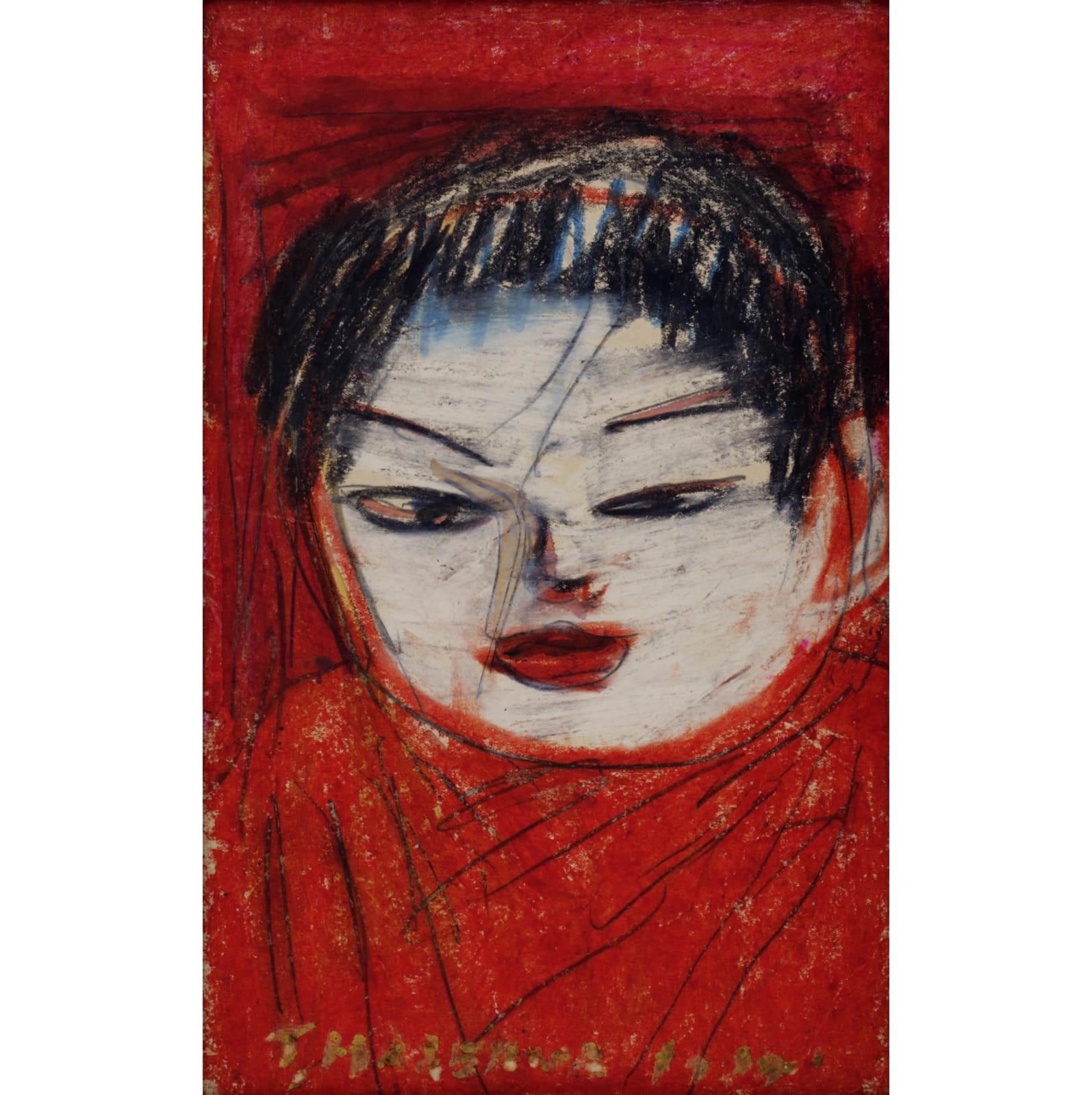Hasegawa Toshiyuki (1891–1940)
Girl
Pastel and pencil on paper, framed
Dated 1929
With label authentication by Kimura Tosuke,
box authentication by Kumagai Morikazu
28 x 17.5 cm
30 x 19.5 cm (overall)
Dated 1929
With label authentication by Kimura Tosuke,
box authentication by Kumagai Morikazu
28 x 17.5 cm
30 x 19.5 cm (overall)
Further images
Literature
The Works of Toshiyuki Hasegawa. Tokyo: Chuokoron Bijutsu Shuppan, 1963.
Hasegawa Toshiyuki always carried around his painting utensils and painted indiscriminately. He purportedly drew in cafes, bars, or on the street and would paint on newspapers or the lids of sweet boxes, if he did not have paper. He would sell his paintings for very little and immediately use the money to buy more paints and alcohol.
This painting, which Toshiyuki made in 1929, received several awards at prestigious exhibitions such as the Nikaten (Second Section Exhibition) and the Teiten (Imperial Art Exhibition). Around the same time, however, he began leading a vagabond life moving from place to place and peddling his art in the lower quarters of Asakusa in Tokyo. The simple lines seen beneath the painted pastels suggest that the artist may have quickly sketched this work on the street and later added colors to it. The young girl—expressed in bold hues of red, white, and black—reflects the richly poetic sentiment of Toshiyuki’s interest in his subject matter over realism and volume, thus conveying a representational intent based on an East Asian sensibility. Toshiyuki painted many young girls and female nudes as well as numerous greatly distorted, sexually ambiguous figures. Perhaps these works express the complex feelings towards children and women held by Toshiyuki, who experienced marriage, the birth of his children, and divorce from his mid-teens to his mid-twenties.
The storage box for this painting was inscribed by the artist’s close friend, the Japanese painter Kumagai Morikazu (1880–1977). The label was added after Toshiyuki’s death by the art dealer Kimura Tosuke (1901–1992), who endeavored to honor the artist’s achievements.
Hasegawa Toshiyuki (yoga painter; 1891–1940)
Kyoto-born yoga painter. Quitted his studies at Taikyu Middle School in Wakayama Prefecture and moved to Tokyo, where he published his novel and poem collections on the one hand, and created paintings on the other. Exhibited his works at Shinko yoga ten, Teiten (Ministry of Education Art Exhibition) and Nika-ten. Received the Chogyu-sho award of Nika-ten, and the Kyokai-sho award at the 1930 nen Kyokai-ten (Exhibition of 1930 Society). His work features bold use of colors and Fauvist style, and its subjects include townscapes and portraits. Published Taika no kishi ni sakarite utaeru, a collection of poems, and other written works. Led a vagrant and unsettled life in his late years.
This painting, which Toshiyuki made in 1929, received several awards at prestigious exhibitions such as the Nikaten (Second Section Exhibition) and the Teiten (Imperial Art Exhibition). Around the same time, however, he began leading a vagabond life moving from place to place and peddling his art in the lower quarters of Asakusa in Tokyo. The simple lines seen beneath the painted pastels suggest that the artist may have quickly sketched this work on the street and later added colors to it. The young girl—expressed in bold hues of red, white, and black—reflects the richly poetic sentiment of Toshiyuki’s interest in his subject matter over realism and volume, thus conveying a representational intent based on an East Asian sensibility. Toshiyuki painted many young girls and female nudes as well as numerous greatly distorted, sexually ambiguous figures. Perhaps these works express the complex feelings towards children and women held by Toshiyuki, who experienced marriage, the birth of his children, and divorce from his mid-teens to his mid-twenties.
The storage box for this painting was inscribed by the artist’s close friend, the Japanese painter Kumagai Morikazu (1880–1977). The label was added after Toshiyuki’s death by the art dealer Kimura Tosuke (1901–1992), who endeavored to honor the artist’s achievements.
Hasegawa Toshiyuki (yoga painter; 1891–1940)
Kyoto-born yoga painter. Quitted his studies at Taikyu Middle School in Wakayama Prefecture and moved to Tokyo, where he published his novel and poem collections on the one hand, and created paintings on the other. Exhibited his works at Shinko yoga ten, Teiten (Ministry of Education Art Exhibition) and Nika-ten. Received the Chogyu-sho award of Nika-ten, and the Kyokai-sho award at the 1930 nen Kyokai-ten (Exhibition of 1930 Society). His work features bold use of colors and Fauvist style, and its subjects include townscapes and portraits. Published Taika no kishi ni sakarite utaeru, a collection of poems, and other written works. Led a vagrant and unsettled life in his late years.







